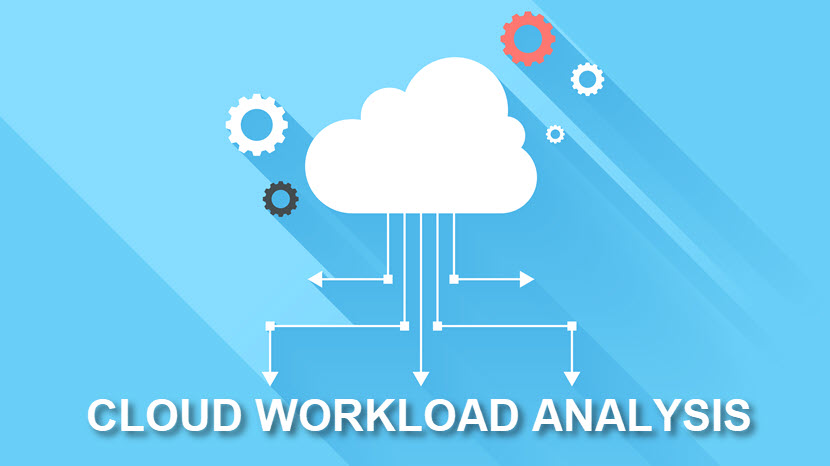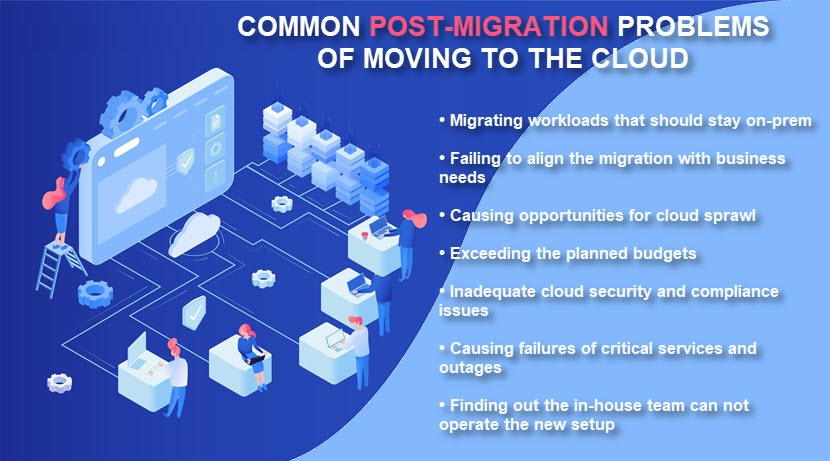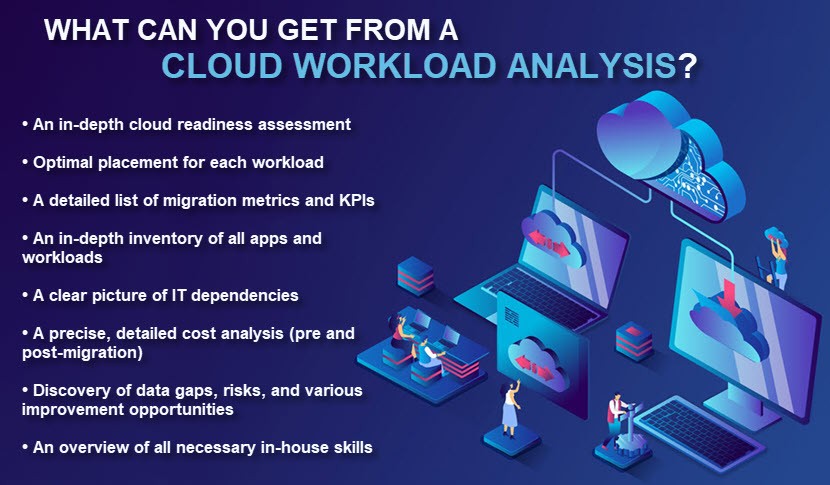Cloud Workload Analysis: How to Determine the Configuration
Cloud adoption can give a competitive edge and revamp your IT, but a poorly planned cloud migration can also lead to unexpected expenses and hard-to-debug performance issues. A smooth transition to the cloud requires timely planning and an in-depth assessment of IT needs, both of which you can get from cloud workload analysis.
This article is an intro to cloud workload analysis, a vital first step in cloud adoption during which a company plans an optimal way to move apps to the cloud. Read on to learn how a cloud workload assessment helps evaluate IT needs, align the cloud migration strategy with business objectives, and prioritize tasks to accelerate cloud adoption.

What Are Cloud Workloads?
A cloud workload is an app, service, or IT capability that consumes cloud-based resources (computing, memory power, networking, etc.). Some common examples of cloud workloads include:
- A virtual machine.
- Cloud databases.
- A microservice.
- Containers.
- Cloud-based content hosting.
- Hadoop nodes and apps.
- Apps for cloud disaster recovery.
Some workload types are not a good fit with cloud capabilities and may perform better on-premises. For example, an app may require processing close to the network edge or can only reside in specific locations due to compliance laws. Workloads that perform best in the cloud have:
- A need for quick infrastructure deployment.
- A short life cycle.
- Capabilities that can benefit from higher levels of distribution.
- Frequent spikes in traffic or usage (either predictable or unpredictable).
Besides some workloads running better on-premises, some apps and workloads perform better on different cloud setups. Evaluating the optimal deployment model for each workload is essential to performance and is a major part of a cloud workload analysis.
Our article on cloud deployment models offers an in-depth look at the five main options you have when choosing where to host cloud workloads.
Types of Cloud Workloads
We can divide cloud workloads based on two factors: resource needs and usage patterns. Based on resource needs, we have:
- General compute workloads that typically run on the default configuration of the cloud (common web apps, web servers, distributed data stores, containerized microservices, etc.).
- CPU-intensive workloads that need high compute levels to handle concurrent users (multiplayer online games, video encoding apps, big data analytics, 3D modeling, etc.).
- Memory-intensive workloads that need excessive amounts of memory and processing to handle transactions (real-time streaming data, caches, distributed databases, etc.).
- GPU-accelerated workloads that need the power of GPUs along CPUs to perform tasks in real-time (self-driven vehicles, navigation systems, seismic analysis, etc.).
- Storage-optimized workloads such as data warehouses, in-memory databases, or NoSQL databases with high scalability needs.
We can also divide cloud workloads based on usage patterns. This categorization goes as follows:
- Static workloads (known needs for resources and availability, such as CRMs, ERPs, or email services).
- Periodic workloads (predictable traffic spikes at specific times of the day, week, month, or year, such as accounting tools or serverless computing).
- Unpredictable workloads (cloud workloads prone to sudden and high spikes in usage, such as social networks, online multiplayer games, video streaming sites, etc.).
PhoenixNAP's Bare Metal Cloud enables you to create a workload-optimized hosting environment with 20 pre-configured instance types that help fine-tune your compute, storage, and networking needs.
What is a Cloud Workload Assessment?
A cloud workload assessment (or cloud workload analysis) is the process of examining the current workload set to determine how best to move them to the cloud. These reports provide a company with:
- An assessment of what workload should go to the cloud and which ones need to stay on-prem.
- An appropriate cloud type (private, public, multi-cloud, etc.) and a relevant delivery model (IaaS, PaaS, SaaS) for every suitable workload.
- An estimate of the initial cost, the total cost of ownership (TCO), return on investment (ROI), and post-migration operational expenses.
- A detailed migration plan (typically called a playbook) that ensures a fast and low-risk cloud migration.
While a cloud workload analysis is primarily a technical review, the assessment also considers your business requirements. Depending on the company's needs and apps, the evaluation can recommend any of the following migration approaches for a workload:
- Lift and shift (rehosting): Capturing a workload on a set of physical or virtual servers and moving the app to a cloud environment with minimal changes to its architecture.
- Extending to the cloud: Extending a workload that runs on-premises to use cloud resources (typically to get the cloud bursting capability).
- Cloud optimization (re-platforming): This cloud migration strategy requires rearchitecting minor or major portions of the app to take advantage of a set of cloud services (such as modifying interactions with the database to take advantage of automation or adding new features for better scaling).
- Cloud-native: A complete rewrite of the app for cloud deployment, such as converting a legacy architecture into an independent microservice.
Alternatively, the evaluation may also suggest that the workload should continue to run on-premises due to compliance, security, or operational reasons. The report may even indicate that the company should remove the workload to achieve better performance.

Common Cloud Migration Concerns (And How Timely Cloud Workload Analysis Solve Them)
Cloud workload assessment solves most major concerns of migrating to the cloud. These problems include:
- The lack of a clear migration strategy in line with business objectives.
- Migrating workloads and apps that should continue to run on-premises.
- Suffering from cloud sprawl (uncontrolled management of cloud instances and services).
- Creating a poorly performing IT environment.
- Exceeding the planned initial budget.
- Creating security weak points or compliance risks.
- Migrating the entire infrastructure at once and causing failures of critical services.
- Discovering that the team lacks the necessary skills to operate the new infrastructure.
- Causing prolonged post-migration availability issues and service outages.
While not a direct solution for these problems, a cloud workload analysis ensures you think about these issues on time. The ability to make informed decisions before and during the migration process is a major concern, as demonstrated by these numbers:
- Over 45% of IT decision-makers indicate they struggle to forecast and understand the costs associated with cloud migration.
- Around 36% of companies looking to migrate to the cloud are unsure about the IT staff's ability to work in the new environment.
- Over 40% of businesses struggle to understand the dependencies and architecture of existing apps before cloud migration.
Once you migrate to the cloud, keeping costs under control becomes a significant part of everyday operations. Here are 14 cloud cost optimization tools to ensure you stay within the budget.
Cloud Workload Analysis Benefits
Below is a close look at the most impactful benefits of cloud workload analysis and what your business stands to gain from investing time and money into a top-tier assessment:
- The company receives an in-depth cloud readiness analysis.
- You learn where each specific workload performs optimally.
- The company gets a list of KPIs and metrics to help keep up with and evaluate the success of the cloud migration.
- Each workload identified as a suitable fit for the cloud receives a match to right-sized cloud resources.
- You receive an in-depth inventory of all apps and workloads, as well as a clear picture of IT dependencies.
- The analysis discovers redundant apps that are no longer necessary for your IT environment.
- You get a precise, detailed cost analysis for your spending before, during, and after the migration (including software licensing and dynamic operating expenditures).
- You minimize the likelihood of migration collapse and critical failures.
- The design of the new cloud environment starts with built-in security considerations.
- The company learns about the skill sets needed to perform the migration and manage the new environment, providing insights into the required training sessions and potential new hires.
Still not sold on the idea of using cloud resources? These 8 business benefits of cloud computing explain why companies are moving away from on-prem setups in record numbers.

How Does Cloud Workload Analysis Work?
Below are the five main steps of performing a workload assessment for cloud suitability. While each team of analysts has a unique order in which they perform tasks, every method includes the steps listed below.
Stage 1: Business Impact
The first step is to evaluate the impact migration will have on the business and lay some groundwork for the rest of the analysis. The assessment team must:
- Define the metrics and KPIs for migrating to the cloud (improved performance to support an increasing number of users, reduced time to deploy a new build, increased frequency of releases, better user experience, etc.).
- Build a comprehensive inventory of apps and workloads.
- Catalog apps according to their properties.
- Identify business-critical workloads and sensitive data (most teams prefer to migrate these sections at the end of the process).
- Gauge the skill level of the in-house team.
- Determine the timeline during which the cloud migration needs to occur (the two main time frames are the start of the migration and how long it takes for the new cloud-based setup to be up and running).
- Determine the level of risk associated with cloud migration (with an accent on compliance and preventing data breaches and leakage).
Stage 2: Initial Workload Analysis
The second step requires the team to assess workloads and start planning for the migration. The team must:
- Understand the company's technical landscape and its unique features.
- Perform a workload classification and determine migration requirements for each workload.
- Map any unique workload-specific constraints, challenges, and needs.
- Run a check for any wasteful legacy workloads that the company can eliminate without impacting operations.
- Mark each workload that is a candidate for migration.
- Consider potential scaling issues for each workload.
- Mark per-workload availability requirements.
Stage 3: Architecture Assessment
The assessment team evaluates application readiness and suitability for a cloud environment. The team must:
- Assess the impact of app migration to the cloud.
- Understand the effect of changing, dispositioning, or replacing each workload.
- Separate the workloads suitable for the cloud from those that are a better fit with on-prem hosting.
- Determine the right approach for migrating each app (lift and shift, re-platforming, complete code rewrite, etc.).
- Decide on the suitable deployment model for each workload (public, hybrid, community cloud, etc.).
- Check if moving to the cloud will impact app licensing.
- Specify if any app could potentially hinder the migration strategy.
- Identify unsupported software and complex code that requires rework.
- Suggest architectural improvements that can lead to more optimal workload and app performance.
- Look for impactful opportunities for orchestration and automation features.
Stage 4: Technical Characteristics Evaluation
The cloud workload assessment team now needs to consider non-architectural features of every relevant workload. The team must:
- Verify the integrations and dependencies of every workload.
- Assess which workloads and apps should be on the same cloud.
- Check the existing workload interoperability factor.
- Determine if any custom features in an app may impact its viability for cloud migration.
- Inspect the support factor for each workload (support document availability, technical diagrams, etc.).
- Rank the ease of migration for each app and workload.
- Account for regulatory compliance requirements (HIPAA, GDPR, PCI, etc.).
- Analyze and suggest upgrades for the current security mechanisms.
- Adjust the security strategy for using cloud resources.
Worried about data safety in the cloud? Our article on cloud storage security explains how providers keep data safe and why the cloud is typically safer than any on-prem setup.
Stage 5: Cost Analysis and Playbooks
Finally, the cloud workload analysis team calculates the price of migration and provides a detailed guide to optimal cloud migration (playbook). The team must:
- Provide the price range for the cloud migration.
- Contrast the cost of hosting the system locally versus hosting it on a cloud.
- Define the approximate post-migration spending.
- Outline the expected ROI.
- Calculate the total cost of ownership (TCO) of the target environment.
- Provide an in-depth playbook that explains how and when the company should approach the migration, what the ideal cloud platform is for each workload, and how the system will look after it starts using cloud resources.
- List all the skills the in-house team will need to perform the shift and run the new environment (the analysts may also develop a training plan for the company's team).
- List all necessary support resources.

Choosing the Right Cloud Workload Analysis Tool
When you decide to run a cloud workload analysis, you have three options:
- Use an in-house team of analysts.
- Outsource the assessment team from a third-party company.
- Use a specialized tool for cloud workload assessments.
While each option has its benefits, only a tool can enable you to start analyzing workloads and making informed decisions in mere minutes.
If you want to see what a workload analysis tool can do for you, CloudGenera is a top-tier assessment platform that uses AI and machine learning to perform tasks humans take weeks or even months to complete. CloudGenera's workload placement platform is a one-stop solution that provides you with:
- An in-depth, holistic analysis of the current workload stack and technology portfolio.
- A clear view of areas and opportunities for modernization.
- Optimization suggestions for lowering costs and enhancing service.
- Vendor-agnostic recommendations on where each of your workloads can have optimal performance.
- Actionable insights on how best to organize your move to the cloud.
- In-depth analysis of your current and future security state.
- Feature-rich cost overview that ensures you stick to the budget both during the migration and after completing your cloud journey.
Start using CloudGenera today to begin making data-driven workload placement decisions and ensure your cloud migration comes with a high ROI.
Never Rush into Cloud Migration
Neglecting to run a cloud workload analysis increases the risk of post-migration performance issues and unexpected costs. Instead of rushing into complex infrastructure changes, organize an in-depth analysis to ensure the cloud migration does not become a prolonged IT headache that takes months to fall into place.